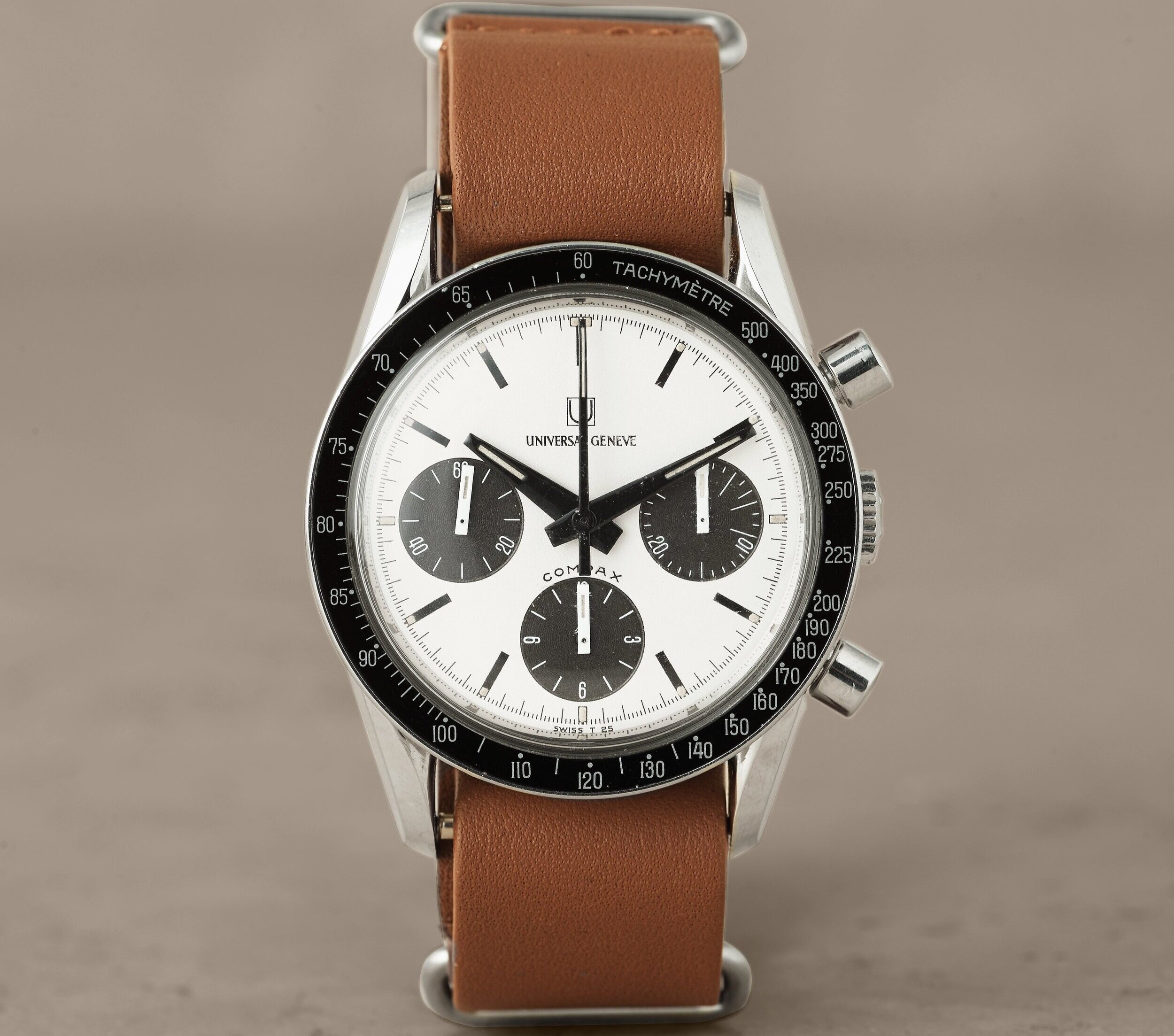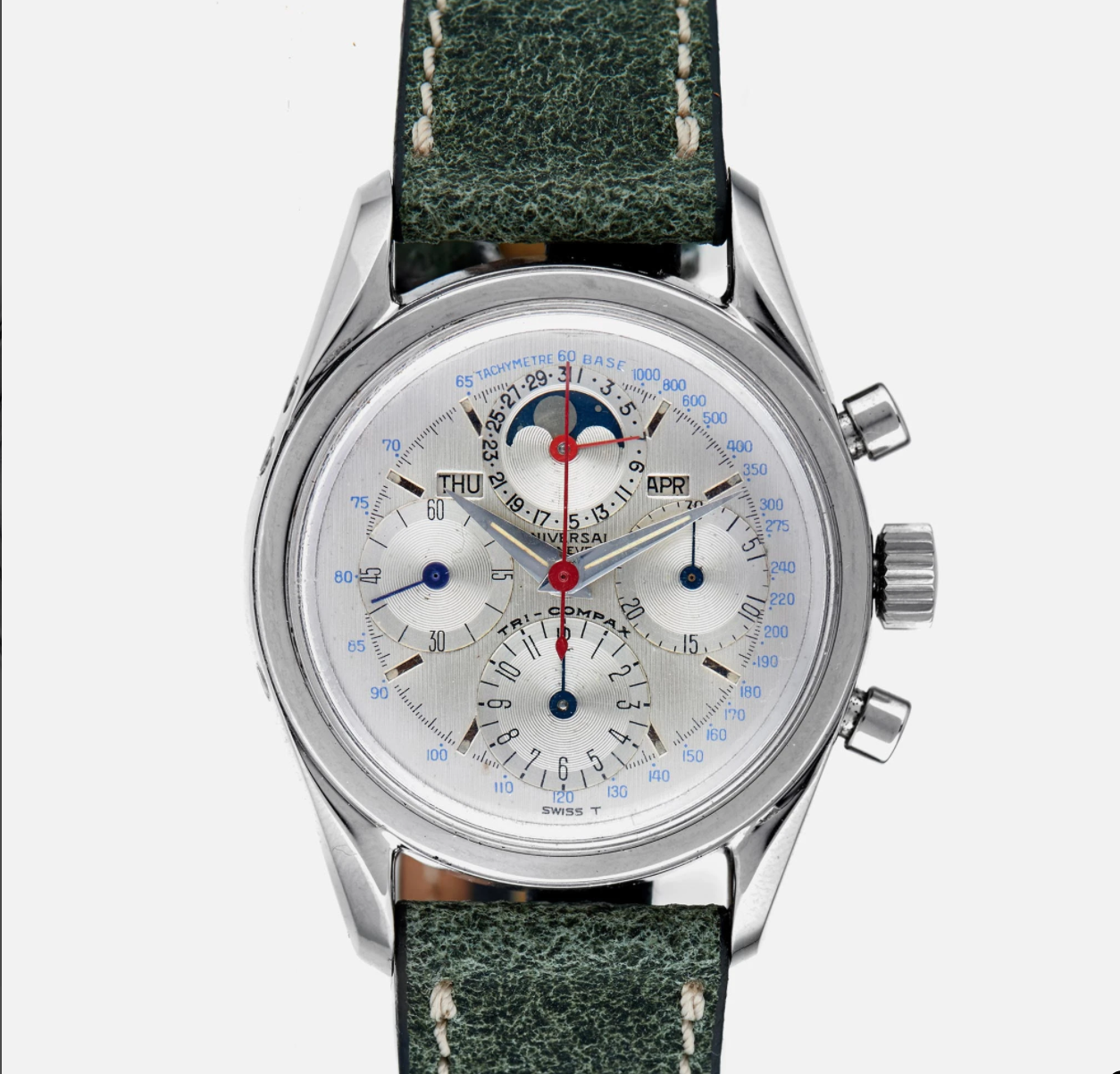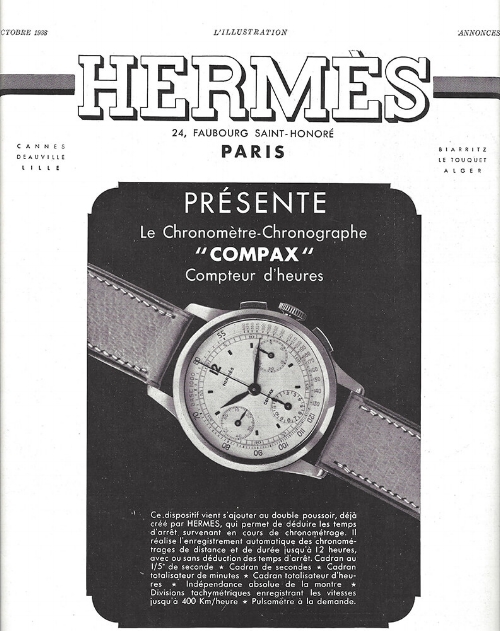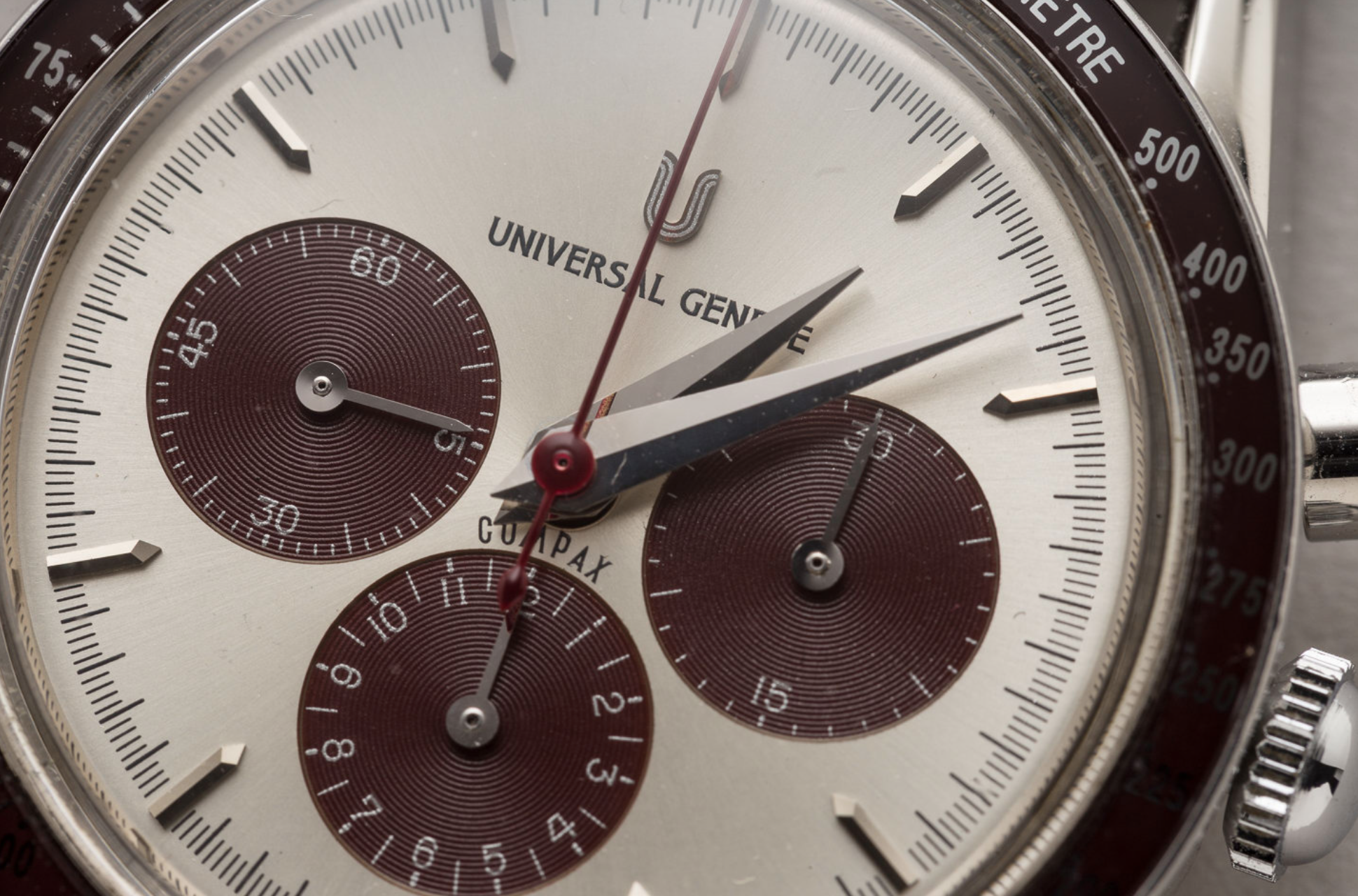Bukowski’s
Subscribe to our weekly newsletter for exclusive content, events, vintage watches for sale, and other cool shit you won’t find anywhere else — not even our website.
A history of Universal Geneve, a cult-like brand to collectors everywhere
For an extinct brand, Universal Geneve has been awfully hot the last few years. As the vintage boom has reached far and wide, collectors have dug deeper into the archives to find reasonably-priced vintage pieces. This means that long-extinct brands like Universal Geneve have seen a renaissance of sorts as a new generation of enthusiasts discover what made them so endearing the first time around. Here, we go in-depth into the brand’s rise and fall, and feature a few of our favorite watches.
[Ed. note: check out our March 2019 brief update to this article, here.]
Universal Geneve’s beginnings
Universal Geneve was founded in 1894 in Le Locle, Switzerland as Universal Watch. The brand began as an establissage, a fancy French work for a workshop that assembled the various parts of a watch. At this time in history, this meant taking delivery of ebauches (movements produced by a third party), inspecting these movements, then fitting the dial, hands, and cases with the movement before packaging the watch up for shipment. By 1919, the brand had officially moved most of its operations to Geneva, completing the transition to Universal Geneve.
The brand was founded by two horology students, and while its roots were in manufacturing, the two founders soon patented their first 24-hour indication watch. During World War I, the brand produced both pocket watches and trench watches for both sides of the conflict (very Swiss of them). By 1925, the brand had moved on to patent and produce its first automatic watch, the Auto Rem. The watch had a distinct octagonal shape. By this time, one of Universal Geneve’s founders had already died; the second founder, Ulysee Perret, died within years of the Auto Rem’s launch. Perret’s son would then take over the business, leaving it a family-run enterprise for the next thirty years.
The Compax and Hermes Era
In 1936, Universal Geneve created its first Aero Compax (short for Aviator’s Compact Chronograph). By this time, wristwatches were beginning to gain in popularity, with the chronograph especially becoming a consumer favorite. The stopwatch functionality not only had everyday utility, but it also lent itself to military use, making it a suitable device for training exercises and combat operations. The Compax became widely recognizable, and was produced in a number of variations over the next decades, including Uni-Compax, Tri-Compax, Moon Phase, and Master Vortex.
Universal Geneve Tri-Compax in steel | Hodinkee Shop
Around this same time, Universal Geneve briefly collaborated with Hermes, designing its Pour Hermes line of chronographs. As such, Hermes became the major sales center for Universal Geneve watches. By this time, the Henri Stern Watch Agency was an authorized dealer of Universal Geneve watches in North America. You may now know Henri Sterm as Patek Philippe U.S. — the Agency is perhaps most famous for bringing Patek Philippe to the United States in 1935 and eventually being folded into the larger Patek Phillipe entity. But, when Patek was brought over, it was sold as a “sister” brand alongside Universal Geneve. Essentially, Universal Geneve became the “poor man’s Patek Philippe,” and so it remains today the poor man’s vintage Patek Philippe. Remember the Tri-Compax we mentioned? That’s basically a non-perpetual calendar Patek Phillip 1518 (it looks strikingly similar). With this kind of chic lineage, Universal Geneve watches can be found for a relative pittance, though those rare Hermes stamped chronographs can fetch premiums of up to 50 percent.
What’s more, Universal Geneve had sourced their chronograph watch movements from the Martel Watch Company since 1918; Martel was eventually acquired by legendary chronograph manufacturer Zenith, lending yet more respected lineage to Universal’s striking pedigree.
An Hermes ad for its Compax, manufactured by Universal Geneve
Universal Geneve and Nina Rindt
Today, perhaps the most desired UG Compax is the “Nina Rindt”, a classic 1960s era chronograph made famous by racing driver Jochen Rindt’s wife, Nina. The Ref 885103 is a panda dial chronograph (black subdials on cream dial), with a black tachymeter bezel, reminiscent of other racing chronographs of the era — Rolex Daytona, anyone? The “Evil Nina” is equally coveted, and is so named because of its reverse panda dial.
Supermodel Nina Rindt rocking a Universal Geneve Ref. 885103.
The Polerouter and Gerald Genta
Finally, we reach the watch that Universal Geneve is perhaps most known for today: the Polerouter. The watch you see all over Chrono24 or eBay, usually costing somewhere between $1,500 and $3,000. The watch was designed by Gerlad Genta, then a young and relatively unknown jewelry designer. While he’d go on to design iconic timepieces such as the Audemars Piguet Royal Oak and Patek Phillipe Nautilus, the Polerouter was his first real stroke of genius.
In 1954, Universal Geneve called on a 23-year-old Genta to design a watch to commemorate Scandanavian Airlines’ polar flights from New York and Los Angeles directly to Europe. Remember, this is also the time of the first Rolex GMT-Master (Reference 6542), which was created for Pan Am pilots as they began flying longer distances. It was the dawn of the Jet Age, and Universal Geneve wanted in on the action.
In 1953, Scandinavian Airlines ran its first ever route over the North Pole, taking off in Norway and landing in Alaska. This soon led to the first commercial route over the North Pole, from Copenhagen to Los Angeles. While this was great news for flight times, it introduced a new problem: exposure to extreme magnetic fields. But, Universal Geneve’s work with anti-magnetic watches meant they were equipped to solve the problem, so Scandanavian Air asked its official timepiece provider to create a new watch for the aviation milestone.
A 1950s Universal Geneve Polerouter | Hodinkee Shop
The watch Genta came up with was the Polarouter (later renamed Polerouter, but still pronounced Pol-a-router). The first few hundred were stamped with the Scandanavian Air logo on the dial, and are thought to be extremely rare. The first Polerouter was release in 1954, featuring a 34.5mm case diameter and distinctive textured dial with no date window.
In 1955, the Polerouter was updated with the new Universla Geneve Cal 215 microrotor movement, which would continue to be produced for the next 15 years. Along with Hamilton, Universal Geneve was one of the first companies to put automatic movements into mass production, affordable watches. Over the proceeding years, the Polerouter saw many variations of its line, including the Polerouter Sub, Polerouter Jet, Polerouter de Luxe, and the Polerouter Date and Day-Date. Many variations of the date window have a unique trapezoid shaping, making them very popular among collectors.
By 1965, the Caliber 2-66 microrotor movement was used to produce the Golden Shadow and White Shadow. This movement was the thinnest automatic movement at the time, measuring just 2.3mm thick. Later Shadow models contained electric movements as the quartz crisis began to effect Universal Geneve and the rest of the Swiss watch industry.
Throughout the 1970s and 80s, Universal Geneve jumped increasingly into quartz production, which proved devastating for the brand. Releases of quartz Polerouter models proved unpopular and short lived, and the brand’s cache, once similar to that of brands such as Omega and Longines, began to suffer.
The Universal Geneve of Today and Tomorrow
A late Universal Geneve Compax from the 1980s
Today, Universal Geneve as a brand is technically still in existence, owned by Stelux, a Hong Kong investment group, since 1989. The brand saw a brief relaunch in 2001, but hasn’t updated its marketing materials or website since 2009. They’re still a member of the Federation of the Swiss Watch Industry, and oversee production of Cyma, another brand owned by Stelux. So what does the future hold for the once thriving brand?
It’s hard to say, and the world of watches if unpredictable. In the past decade, we’ve seen the hyper-successful relaunch of Tudor, something no observer would have predicted at the time. For Universal Geneve, a brand that held a similar (if not increased) position in the pantheon of vintage watches, this could be a model for the future. But, the Tudor relaunched has been masterfully executed by Rolex and the Hans Wilsdorf Foundation. It’s not something every brand can manage. But, at a time when “heritage” watches and homages from legacy brands or microbrands are launching weekly, there may be a market for a Universal Geneve relaunch. It’s not hard to imagine a scenario in which Universal Geneve relaunches a heritage Polerouter, packed with an ETA 2000 series movement and priced at under $2,000, that becomes wildly successful.
But for now, we’ll have to “settle” for the vintage Polerouters. And that’s not all bad either.
Update: As of March 2019, it’s been brought to our attention that the Universal Geneve website is fully operational. Hell yea.






